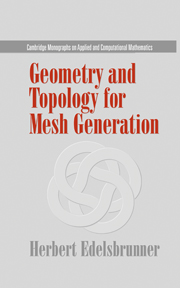6 - Tetrahedron meshes
Published online by Cambridge University Press: 03 October 2009
Summary
This chapter studies the problem of constructing meshes of tetrahedra in ℝ3. Such meshes are three-dimensional simplicial complexes, the same as what we called tetrahedrizations in Chapter 5. The new aspects are the attention to boundary conditions and the focus on the shape of the tetrahedra. The primary purpose of meshes is to provide a discrete representation of continuous space. The tetrahedra themselves and their arrangement within the mesh are not as important as how well they represent space. Unfortunately, there is no universal measure that distinguishes good from bad space representations. As a general guideline, we avoid very small and very large angles because of their usually negative influence on the performance of numerical methods based on meshes. Section 6.1 studies the problem of tetrahedrizing possibly nonconvex polyhedra. Section 6.2 measures tetrahedral shape and introduces the ratio property for Delaunay tetrahedrizations. Section 6.3 extends the Delaunay refinement algorithm from two to three dimensions. Section 6.4 studies a particularly annoying type of tetrahedron and ways to remove it from Delaunay meshes.
Meshing polyhedra
In this book, meshing a spatial domain means decomposing a polyhedron into tetrahedra that form a simplicial complex. This section introduces polyhedra and studies the problem of how many tetrahedra are needed to mesh them.
Polyhedra and faces
A polyhedron is the union of convex polyhedra, P = ∪i∈I ∩ Hi, where I is a finite index set and each Hi is a finite set of closed half-spaces. For example, the polyhedron in Figure 6.1 can be specified as the union of four convex polyhedra.
- Type
- Chapter
- Information
- Geometry and Topology for Mesh Generation , pp. 111 - 135Publisher: Cambridge University PressPrint publication year: 2001



